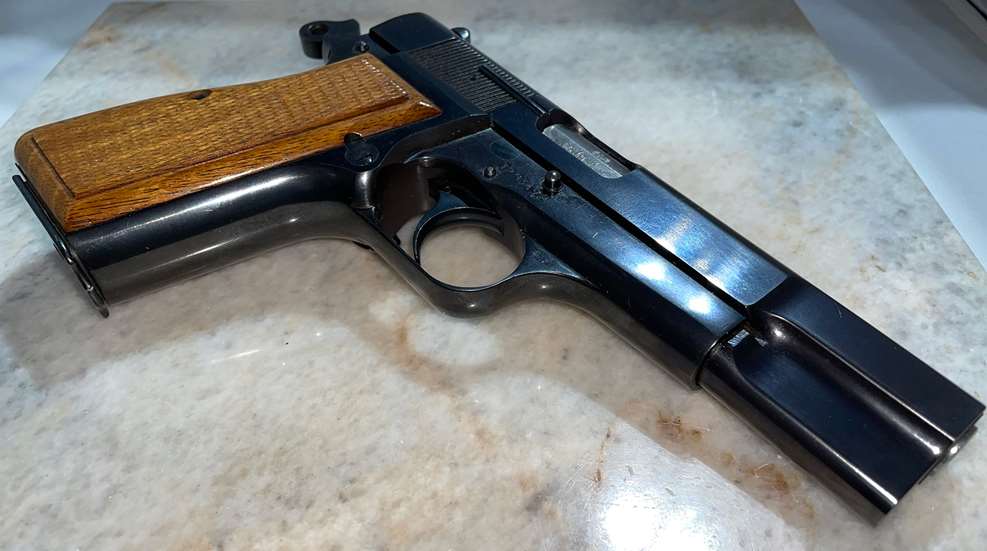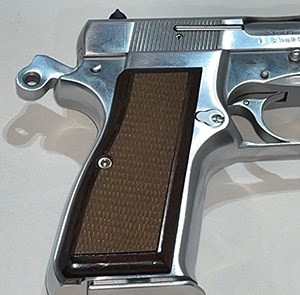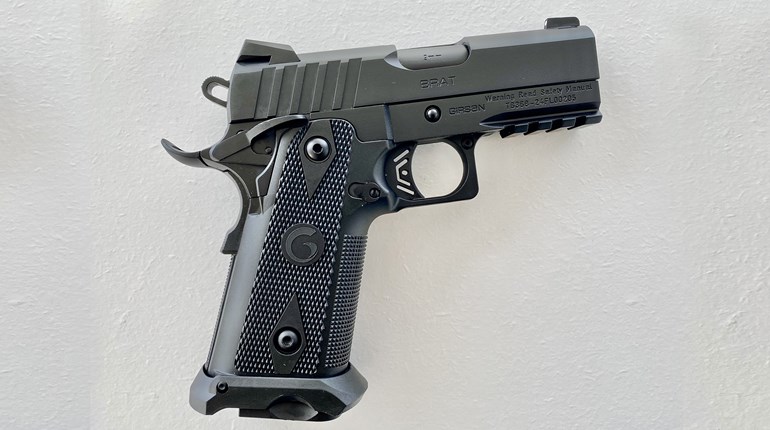
As a gunwriter, one can correctly assume that I have an affinity for firearms. Much like Will Rogers who once remarked, “I never met a man I didn’t like,” I feel a similar kinship with all things that go bang. However, despite this universal fondness for firearms, there are some guns that will always hold a special place in my heart. One of which is the venerable 1911. Dozens of examples, across a wide spectrum of brands, currently reside in the Boyd Bunker. (In fact, my love for the platform inspired me to become an AGI-certified 1911 armorer in 2016 with the intention of learning how to build my own 1911 from scratch.)
Similarly, the Browning Hi Power also ranks quite stratospheric on the Bob-smitten meter. Why? There are many reasons. For one thing, even when wearing OEM grips it feels superb in the hand. A fellow gunscribe at hipstertactical.com put his trigger finger on it when he writes, “From the very first moment you hold one, the Browning Hi Power feels strikingly familiar, evoking a visceral sense of connection that makes it handle like it’s an extension of you. As a kid, if you ever dreamed of what it felt like to hold a real handgun… you dreamed of the Browning Hi Power. It’s quintessential. It’s definitive. It’s an archetype—one that seems to permeate the collective unconscious of gun enthusiasts everywhere. It’s everything you ever imagined a “handgun” to be. And, for many, it’s everything you want a handgun to be. And more.”
Absolute 100-percent, USDA-certified truth. As a member of Gen X, I had the same experience more than 40 years ago the moment my father handed me his Belgian-made Browning Hi Power for the first time. As a 10-year-old kid, the pistol felt like it belonged in my hand, and it still does whenever I handle one today. However, handling any number polymer-frame semi-automatics that are so popular today feels detached, soulless and downright clinical by comparison.
While it’s true that the Browning Hi Power came from the same fertile mind as the one who created the venerable Colt 1911 service pistol—that of the great John Moses Browning—to discuss what sets the Browning Hi Power apart from the gunmaker’s other creations, a bit of a history lesson is in order. To truly understand the significance of the Browning Hi Power, one must rewind to a time prior to its creation, specifically to the time when the U.S. Army was conducting trials for a new potential service pistol in 1907.
The manufacturers of 20 semi-automatic pistols and revolvers had been invited to participate in the trials with seven semi-automatics, two revolvers and one semi-automatic revolver making it to the actual test stages. Competing handguns included the Knoble, the Bergman, the Luger, the Savage 1906, The White-Merrill and The Webley-Fosbury, among others. According to an article on NRA’s Shooting Sports USA website regarding the 1907 Army Pistol Trials, “By the time Secretary Dickinson adopted the Colt in 1911, only one other gun, a Savage, was still in the running.” In the end, Browning’s creation came away victorious.
Later, Browning would eventually make a deal with Colt’s Patent Fire Arms Manufacturing Co. (now Colt’s Manufacturing Co.) of Hartford, CT, for his most important pistol: the Colt 1911 chambered in .45 ACP. For rights to produce the aforementioned semi-automatic pistol, the Browning Automatic Rifle (BAR) and a new lightweight machine gun he’d been working on that would eventually become known as the M2 (and later to affectionately known as "Ma Deuce") he patriotically accepted $750,000 from the U.S. government in 1917 in lieu of royalties. In other words, what would otherwise sound like a fairy-tale ending is merely the beginning for what would become Browning’s final creation.
Rather than expound the history of the Hi Power, for those who wish to learn of the pistol’s intriguing history in a condensed format, I direct you to this masterfully written article by Dave Campbell, which details the outline for the new project and the inventor’s unforeseen limitations that would arise from the sale of Browning’s patents to the United States Government.
 So, what are the takeaways thus far pertaining to the Hi Power, its cult-like following and undeniable coolness factor? Consider these:
So, what are the takeaways thus far pertaining to the Hi Power, its cult-like following and undeniable coolness factor? Consider these:
- The Hi Power’s history involves a story of two pistols, not one; it dates back to the 1911 and even “Old Slabside’s” predecessor. Additionally, even though both came from the fertile brain of John Moses Browning, the tale of those two handguns are one of a history, marketing and development that came from completely opposite directions, which would ultimately impact their status and availability throughout history.
- While Browning can only be crediting for designing part of the Hi Power, those parts he did design (namely the frame, the slide, the extractor) etc., are the culmination of everything he had learned over his entire career, which is why when one picks up a Hi Power, it just feels so right in the hand, has an superb balance, points extremely well and literally feels like an extension of your arm. In short, this culmination of decades of gun design equates to the pixie dust that is “secret sauce” that HipsterTactical referenced as to why the pistol emotes the feelings it does among fans and newcomers.
- Historians confirm that John Browning passed away while working on his plans for the pistol at his office in Liege, Belgium. As such, there is this sort of sense that when you clean, examine, purchase, modify or shoot a Hi Power, you are in essence handling his final—and perhaps his best—piece of work.
- I have vivid memories of reading gun magazines during the ’80s in the height of the famed “Wonder Nine Wars” and the countless high-capacity pistols that followed as a result. Obviously, Browning’s Hi Power pre-dated the craze by literal decades. Yet, despite being the original “Wonder Nine,” and while several gunwriters referred to it as such, I find it quite ironic that the pistol was never marketed that way. I firmly believe Browning/FN could have easily plastered full-page ads in all the popular firearm periodicals of the day containing a “beauty shot” of the pistol along with five simple words: “The Original Wonder Nine, since 1935,” which I suspect would have resulted in epic sales numbers. Sadly, we’ll never know. Executives at FN Herstal made the decision to cease production of the pistol in 1993—at a time when the Hi Power was the number-one handgun on the planet in military and law enforcement—though production actually didn’t stop until 2018 in order to give the company time to finish servicing its institutional customers, militaries and law-enforcement entities that it had sold Hi Powers to over the years. The process of completing the myriad servicing obligations took 25 years.
- The Hi Power is one of the most widely used military pistols in history, having been used by the militaries, law-enforcement agencies or security forces in at least 93 countries. Although most pistols were built in Belgium by FN Herstal, licensed and unlicensed clones were built around the world, in countries such as Argentina, Hungary, India, Bulgaria and Israel.
While it may have had a challenging start, the Hi Power eventually found its place in the world of handguns—only to eventually gain worldwide recognition and respect around the globe—and along the way it enjoyed a healthy production run at FN for more than 80 years. With such a track record, it’s hard to believe how such a design could possibly be improved upon.
However, for those firearm enthusiasts who possess an incessant urge to tinker with a firearm by modifying it with the goal of making a firearm truly theirs, the Browning Hi Power is no different. The following is a step-by-step tutorial detailing how to take one of the most popular, battle-proven sidearms in the world and make it even better in the process.
In the next entry, we’ll discuss any technical manuals and/or tools that may come in handy.




































